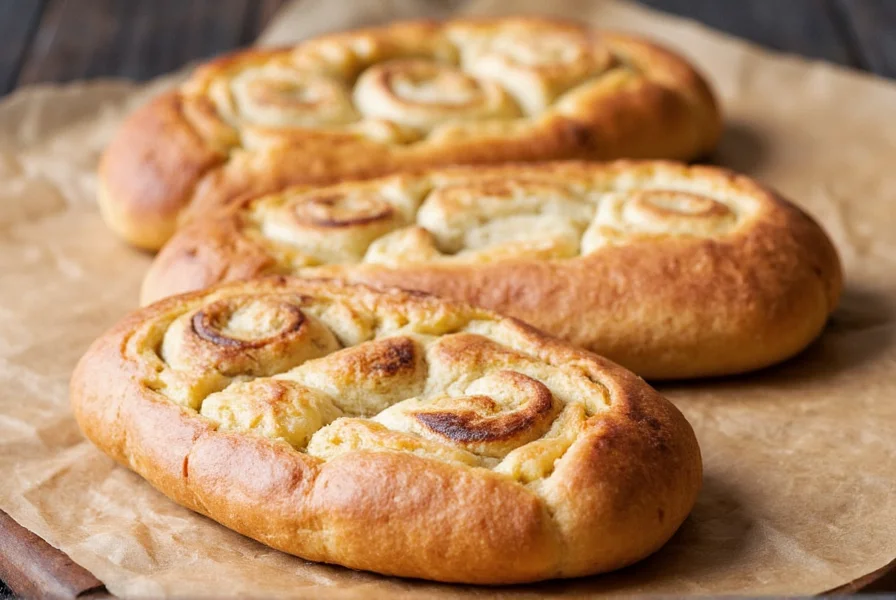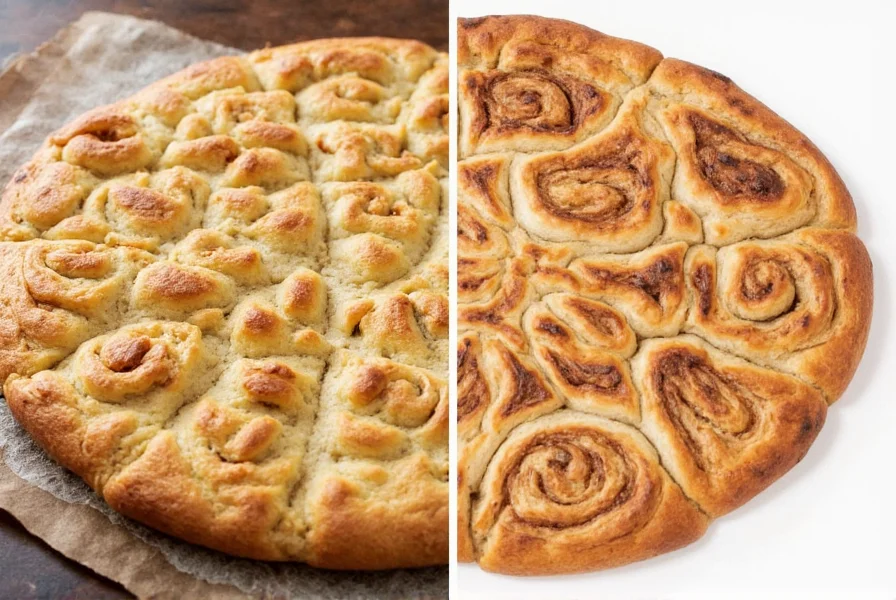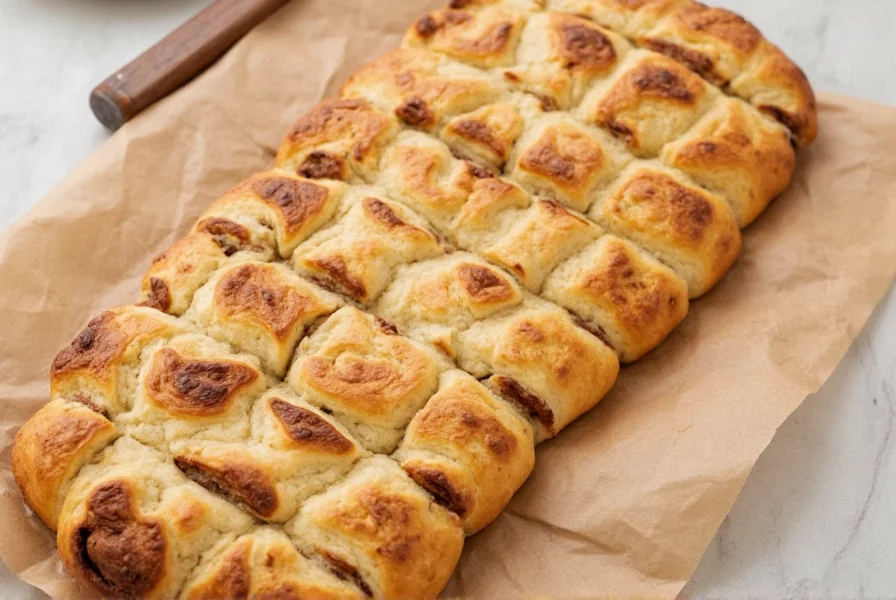Creating the perfect cinnamon roll focaccia requires understanding both baking traditions. Unlike standard focaccia which relies on olive oil and herbs, this sweet variation incorporates butter, sugar, and cinnamon while maintaining the characteristic dimpled surface and chewy texture. The magic happens when you layer cinnamon sugar between stretched dough pieces, creating pockets of flavor that caramelize during baking.
What Makes This Cinnamon Roll Focaccia Special
This innovative recipe bridges culinary traditions by transforming savory focaccia into a sweet breakfast treat. The key innovation lies in the lamination technique—instead of rolling the dough like traditional cinnamon rolls, you stretch and layer it like focaccia while embedding cinnamon sugar between the layers. This creates a unique pull-apart texture with visible swirls throughout the bread.
Professional bakers appreciate this method because it solves the common problem of uneven cinnamon distribution. The layered approach ensures every bite contains the perfect balance of sweet spice and yeasted bread. Food scientists note that the higher sugar content requires careful temperature control during proofing to prevent over-fermentation.

Essential Ingredients and Equipment
Using quality ingredients makes a significant difference in this hybrid recipe. The dough requires standard focaccia components with strategic sweet additions. Note that ingredient temperatures affect gluten development and yeast activation—always use room temperature liquids unless specified.
| Ingredient | Amount | Key Purpose |
|---|---|---|
| All-purpose flour | 3 ½ cups (440g) | Provides structure while maintaining tenderness |
| Active dry yeast | 2 ¼ tsp (7g) | Leavening agent for proper rise |
| Granulated sugar | ¼ cup (50g) | Feeds yeast and enhances browning |
| Salted butter, melted | ⅓ cup (75g) | Creates tender crumb and rich flavor |
| Cinnamon sugar filling | ⅔ cup (130g) | Mixture of ½ cup sugar + 2 tbsp cinnamon |
Step-by-Step Baking Instructions
Follow these precise steps for optimal results. Temperature control proves critical—dough temperature between 75-80°F (24-27°C) yields best fermentation. Use a digital thermometer for accuracy.
- Activate yeast: Combine warm water (105-110°F), sugar, and yeast. Wait 5-7 minutes until foamy.
- Mix dough: In stand mixer, combine yeast mixture, flour, salt, and melted butter. Knead 8 minutes until smooth and elastic.
- First proof: Place dough in oiled bowl, cover, and let rise 1.5 hours until doubled.
- Prepare filling: Mix cinnamon and sugar. Melt additional butter for layering.
- Shape: Roll dough into 12x16 inch rectangle. Brush with melted butter, then sprinkle cinnamon sugar evenly.
- Layer technique: Cut dough into strips, stack them like an accordion, then stretch gently into rectangle again.
- Second proof: Transfer to oiled pan, dimple surface, cover, and proof 45 minutes.
- Bake: 375°F (190°C) for 22-25 minutes until golden brown and internal temperature reaches 190°F (88°C).
Professional Baking Tips for Success
Avoid common pitfalls with these expert techniques:
- Dough hydration: Maintain 65% hydration ratio—add water 1 tbsp at a time if too dry
- Layering method: Stack dough strips vertically rather than rolling for better swirl distribution
- Temperature control: Proof in draft-free area at exactly 78°F (26°C) for consistent results
- Baking surface: Use light-colored aluminum pan to prevent bottom burning
- Cooling: Wait minimum 20 minutes before slicing to set crumb structure

Troubleshooting Common Issues
Even experienced bakers encounter challenges with this hybrid recipe. Here's how to fix frequent problems:
| Issue | Probable Cause | Solution |
|---|---|---|
| Dense texture | Over-proofing or insufficient kneading | Reduce proof time by 15 minutes; ensure proper gluten development |
| Leaking filling | Too much butter or sugar quantity | Reduce filling by 20%; chill dough 10 minutes before baking |
| Pale crust | Oven temperature too low | Preheat oven 25°F higher; use oven thermometer for accuracy |
| Uneven swirls | Inconsistent layering technique | Use ruler to measure dough strips; maintain even pressure when stacking |
Serving and Storage Recommendations
Enjoy your cinnamon roll focaccia at its peak quality by following these guidelines:
- Optimal serving temperature: 120-140°F (49-60°C)—warm but not hot
- Recommended accompaniments: Vanilla glaze, cream cheese frosting, or simply dusted with powdered sugar
- Room temperature storage: 2 days in airtight container with parchment between slices
- Freezing instructions: Wrap tightly in plastic then foil; freeze up to 3 months. Thaw at room temperature.
- Reheating method: 30 seconds in microwave or 5 minutes at 300°F (149°C) in oven
Variations to Try
Once you've mastered the basic cinnamon roll focaccia recipe, experiment with these creative adaptations:
- Nutty version: Add ½ cup chopped pecans or walnuts to the cinnamon sugar mixture
- Fruity twist: Sprinkle ¼ cup dried cranberries or raisins between layers
- Spiced upgrade: Incorporate ½ tsp cardamom or nutmeg into the cinnamon mixture
- Gluten-free option: Substitute with 1:1 gluten-free flour blend and add 1 tsp xanthan gum
- Vegan adaptation: Use coconut oil instead of butter and maple syrup instead of honey
Frequently Asked Questions
Can I make cinnamon roll focaccia ahead of time?
Yes, prepare through the second proofing stage, then refrigerate covered for up to 12 hours. Remove 30 minutes before baking and proceed with recipe. This cold fermentation actually enhances flavor development.
Why does my cinnamon roll focaccia deflate when I dimple it?
This happens when the dough has over-proofed. The gluten structure becomes too fragile. To prevent this, reduce proofing time by 15-20 minutes and use a light touch when dimpling—press gently with oiled fingertips rather than knuckles.
Can I use instant yeast instead of active dry yeast?
Yes, substitute instant yeast at a 25% lower quantity (1 ¾ tsp instead of 2 ¼ tsp). Mix it directly with dry ingredients rather than activating in water first. This method often produces more consistent results for sweet doughs.
How do I prevent the cinnamon sugar from burning?
Create a protective barrier by brushing melted butter over the dough before adding cinnamon sugar. Use light-colored pans which distribute heat more evenly, and tent with foil during the last 10 minutes of baking if browning too quickly.











 浙公网安备
33010002000092号
浙公网安备
33010002000092号 浙B2-20120091-4
浙B2-20120091-4